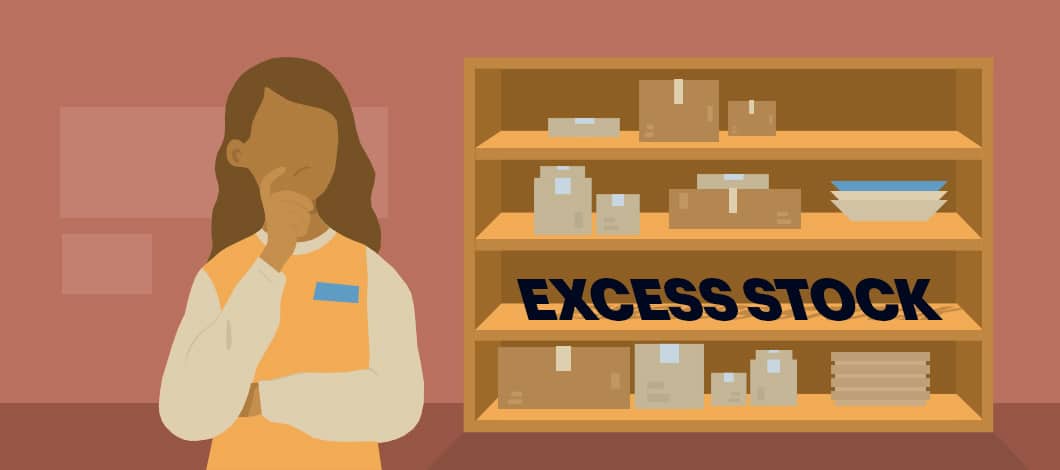Knowing how to sell overstock inventory can keep revenue flowing and prevent cash crunches.
Here are 12 ways to move excess items. We’ll cover what overstock inventory is, why it can be a problem, what causes it, how to avoid it and how to sell excess items efficiently.
What Is Overstock Inventory?
Overstock items can be defined as unsold products in your inventory in volumes that exceed sales projections.
For example, a company that buys too much candy for Valentine’s Day may have extra candy left over after the holiday. Such excess items are unlikely to be sold without adjusting your marketing and sales strategy through methods such as holding discount sales.
Left unsold, excess items will need to be returned to the supplier or disposed of in some other way which represents a loss. For example, in the case of excess candy, some products might have to be destroyed after they pass their expiration date.
Why Is Nonmoving Inventory a Problem?
Excess inventory creates a number of problems that can hurt your business:
- Purchasing inventory that doesn’t get sold wastes valuable financial resources, diminishing your cash flow
- Storing excess inventory wastes space and money
- Keeping overstock takes up shelf space which could be used for profitable items
- Paying to return excess inventory costs money
- Overstocking perishable items risks having to destroy merchandise at a loss
In these various ways, overstock consumes cash and cuts into profits. Left unchecked, excess inventory potentially can put you out of business.
What Causes Inventory Overstocking?
Excess inventory can pile up for a number of reasons:
- Miscalculations of consumer demand can lead to excess stocking
- Changing market conditions or weather may lower consumer demand or alter purchasing habits
- Shipment delays may cause items to arrive out of sync with sales demand cycles
- Technical issues such as poor inventory tracking systems may make inventory levels difficult to monitor and manage
- Returns may cause inventory to accumulate
Granted, some of these issues, such as market and weather conditions, lie outside the control of business owners. However, most of these factors can be managed to at least some degree to avoid and mitigate overstock issues.

How to Sell Excess Inventory Fast: 12 Ways to Clear Overstock
Strategies for managing excess inventory fall into a few general categories, including:
- Better inventory management tracking to keep overstock from accumulating
- Adjusting marketing and sales tactics to accelerate sales to customers
- Recovering partial value of inventory through liquidation
- Disposing of inventory without selling it in ways that indirectly increase revenue or reduce expenses
With that in mind, here are 12 ways to apply these general strategies:
1. Automate Your Inventory Tracking
Good inventory management starts with accurate inventory tracking. Automating your inventory tracking can provide you with the data you need to give you an early warning signal before overstock gets out of hand.
An easy way to automate inventory tracking is to use a point-of-sale system with inventory tracking capability, such as Cin7, or an inventory management app that syncs with popular accounting apps, such as Fishbowl.
2. Use Just-In-Time Inventory Management
Just-in-time (JIT) inventory management leverages automated inventory tracking by combining it with business intelligence to forecast sales demand.
Orders to restock inventory then can be placed automatically when your monitoring system indicates stocks are below projected demand so that new inventory ships and arrives close to the time when it is needed for sale and in the appropriate volume.
This helps keep excess inventory from piling up ahead of sales cycles, reducing storage costs in the process. Inventory management software such as TRXio can help you implement JIT methods.
3. Adjust Your Marketing Angle
Slow inventory movement may reflect a marketing strategy misaligned with your target market. When this is the case, you may be able to improve your sales by changing elements of your marketing approach, such as which benefits you’re emphasizing, who you’re selling to or what keywords you’re using to reach your buyers.
Use your market research data to help you identify ways you might adjust your selling angle to move more inventory.
4. Hold an Inventory Clearance Sale
Adjusting your sales strategy offers another way to move excess inventory. A simple way to do this is lowering prices on overstock by holding an inventory clearance sale.
To justify lowering your price, you can tell customers you’re holding an inventory clearance sale or you can come up with other reasons for holding a sale. Inventory clearance sale ideas include holidays, business events such as new location openings and cultural events such as sports championships. To add urgency, you can promote it as a one-day-only flash sale.
When discounting prices, make sure you keep your prices high enough to maintain a profit margin.
5. Sell Excess Inventory Online
Your website provides a ready-made venue for showcasing inventory you want to move and discounts you want to promote.
Place ads for your inventory sales at strategic places on your site. Use other digital channels such as email marketing, social media profiles and search engine ads to drive traffic to inventory sale offers.
6. Showcase Excess Inventory on Your Shelves
Inside your store, where you place items can help move excess inventory. First and foremost, make sure any inventory items you’re trying to move are visible and not pushed back behind other items.
To showcase sales items, make the most of end caps, displays and checkout line shelves.
7. Bundle Overstock Items with Fast-Moving Stock
A variation on discounting overstock items is bundling them with other products which are selling better. This way the high-demand item then can drive sales of the overstock item, which is included with it at a reduced price but still high enough to turn a profit.
This tactic can work especially well if the overstock item makes a natural fit for the other item.

8. Offer Overstock Items as Bonuses
Overstock items can serve as bonuses offered as incentives or rewards. To do this without taking a loss, the bonus item should serve to steer sales toward another item to offset its cost.
For example, you can run a buy one, get one free sale. Alternately, consider giving every customer who purchases a high-demand item a bonus.
9. Offer Giveaways
As with bonuses, giveaways of overstock items can steer sales toward other items. You can offer a free giveaway to every 10th customer who buys a particular item.
Another tactic is offering giveaways in raffle contests which serve to bring customers into a store, where they may purchase other items.
10. Offer Bulk Discounts
Bulk discounts offer a variation on inventory sales which can serve to move larger amounts of items. You won’t earn as much per unit, but you’ll sell more items, while building customer relations in the process.
Note this tactic works especially well to build repeat business relationships with long-term clients who need to buy the same item regularly.
11. Liquidate Overstock Inventory
When you can’t sell overstock to your regular customers efficiently, there may be another way to unload it. Liquidate the overstock by selling it to other companies which purchase surplus inventory at discounted rates. While you won’t earn as much per unit as you would from selling to customers, you may be able to salvage part of the value of your inventory which you would otherwise lose.
Sites such as Liquidation.com help you connect with surplus buyers.
12. Donate Overstock as a Tax Write-Off
An alternative to selling inventory is to donate it to a charity as a tax write-off. Why? This allows you to recover some of your costs even without selling the item. Under Internal Revenue Service (IRS) regulations, corporations generally can donate inventory to any qualified charitable organization.
Because tax regulations governing inventory donations can be somewhat complex, consult your accounting professional for how to apply them.
Sell Overstock Inventory to Increase Your Profit Margins
Overstock happens when unsold inventory accumulates in volumes that exceed sales projections. This can waste financial resources and shelf space, preventing storage from being used for more profitable inventory while creating cash-flow problems.
Inaccurate sales forecasts, shipping delays, poor inventory tracking and other factors can cause excess inventory. Methods for managing overstock range from strategies for preventing overstock from accumulating to tactics for recovering the partial value of overstock. Also, strategies such as discounts, bundling, liquidation and tax write-offs can salvage at least part of the overstock value.
Use these methods to help you avoid and reduce overstock losses so you can maintain healthy movement of inventory and sustain profitable sales.










